Enhancing Avian Well-Being with Extra Large Bird Toys
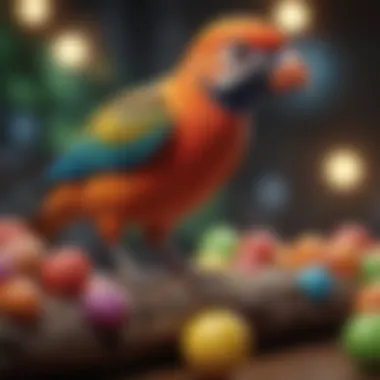
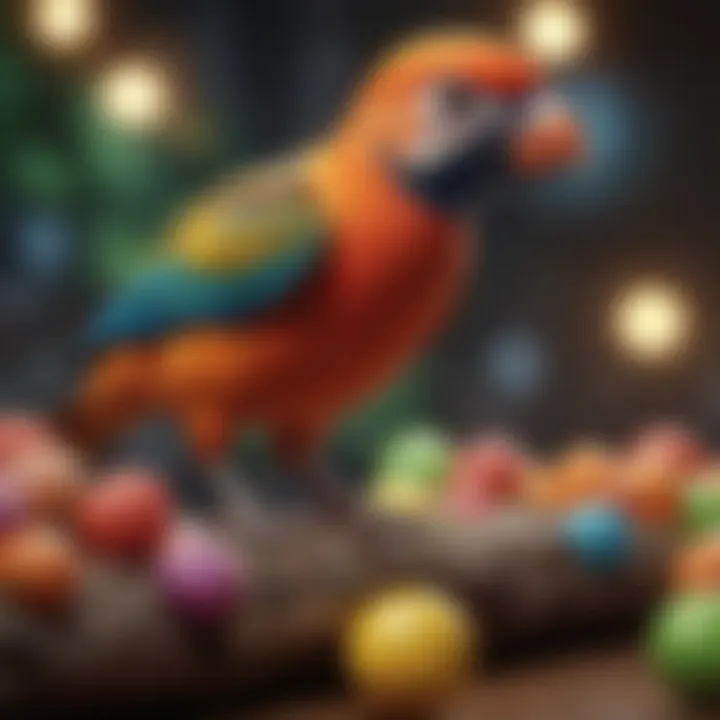
Intro
When it comes to providing a happy and healthy life for our feathered friends, extra large bird toys play a pivotal role. These toys not only captivate a bird's attention but also serve as an essential avenue for mental and physical stimulation. Many pet bird owners might overlook the importance of selecting the right toys, especially when it comes to size. Tiny toys simply don’t cut it for larger species; it can be like trying to fit a square peg into a round hole.
Why focus on extra large bird toys? This is simple. Birds, especially those with more significant body sizes, need the right tools to keep boredom at bay. These toys can foster playful behavior, allowing birds to exercise their natural instincts, such as chewing, climbing, and foraging. In this article, we’re going to explore various aspects of these toys, emphasizing their importance in avian enrichment and the guidelines for their effective usage.
Care Tips
Creating an engaging environment for your pet bird involves a commitment to their care. The selection and maintenance of extra large bird toys is a key component of this commitment. Here are some tips to ensure that your feathered buddy thrives:
Daily Care Routines
Every bird owner is familiar with the daily routines that help keep their birds healthy. Checking on your toys should be part of this ritual. Inspect for wear and tear – nicks, cracks, or anything that might pose a safety hazard. Rotate toys regularly to keep your bird interested. A toy that’s a few days old can feel thrilling again after a break.
Cage Setup and Maintenance
The setup of your bird’s cage can greatly influence their enjoyment of toys. Ensure there is ample space for moving around. Hang extra large toys at various heights to encourage climbing and exploration. This setup not only makes the cage more interesting but can significantly reduce stress.
Hygiene and Cleaning Practices
Let’s face it: cleanliness matters. Birds can be messy, and toys can accumulate droppings and debris over time. Regular cleaning is crucial for preventing any buildup of bacteria. Use bird-safe cleaning products to wipe down toys on a regular basis. An easy solution is to soak wooden toys in a solution of vinegar and water, followed by a rinse with clear water.
Seasonal Care Adjustments
Birds can experience stress due to seasonal changes. As the weather changes, so should your approach to toy management. In colder months, consider incorporating plush or soft toys that offer comfort. Conversely, in hotter months, provide toys that encourage cooling behaviors, like water baths.
Behavioral Insights
Understanding your bird’s behavior is essential in maximizing the benefits of extra large toys. This requires keen observation and the ability to interpret their body language.
Understanding Bird Body Language
Birds communicate a lot through their body language. Flapping wings, head tilting, and even standing tall can indicate different moods or desires. Recognizing these signs can help determine if a bird is feeling bored or if it’s time to introduce a new toy.
Common Behavioral Issues and Solutions
Disinterest or destructive behavior are two common issues birds may face. If a bird is constantly chewing wood instead of their toys, it might be time to rethink. Introduce materials that mimic their natural environment or switch up the textures and shapes.
Positive Reinforcement Techniques
Bird training doesn’t have to be a chore. Using their favorite toys as a reward can turn into a delightful experience. By associating a behavior with a positive outcome—like playing with a toy after performing a trick—you strengthen the bond with your bird.
Social Interaction Needs
Birds are social creatures. Maintaining a balance between solo play and social interaction with their human companions is essential. Consider getting multi-functional toys that require participation, enhancing connection time.
Nutrition Guides
While toys are significant, the nutritional aspect cannot be ignored. Birds need a balanced diet to maintain their vitality, which complements their playtime.
Essential Diet Components
Birds thrive on a diverse diet. Grass seeds, grains, and colorful vegetables should be a staple. Extra large bird toys can serve as a distraction while chewing on healthy snacks. Incorporating foraging toys can help them search for hidden treats.
Safe and Toxic Foods
Understanding what to avoid is as crucial as knowing what to provide. Familiarize yourself with common toxic foods like avocado and chocolate, keeping your bird safe.
Supplements and Treats
Don’t underestimate the role of supplements. They can play a part in fulfilling dietary deficiencies, especially in hand-fed chicks. Introduce natural treats like nuts or dried fruit but be mindful of portions.
Feeding Strategies for Different Species
Tailor your feeding approach depending on your bird’s species. For instance, while African Greys may enjoy nuts, budgies might prefer seeds and leafy greens. Each type requires specific nutritional needs that impact their play activities.
Wellness and Health
A proactive approach to your bird’s health and wellness not only maximizes their playtime but enriches their life overall. Regular health assessments are necessary.
Routine Health Checkups
Routine visits to an avian vet ensure your bird stays healthy. Schedule checkups at least once a year, or more frequently depending on their age or any medical conditions.
Identifying Symptoms of Illness
Be vigilant of any changes in behavior or appetite. Aggressive feather plucking or aggressive behavior can signal underlying issues. Compare your bird’s playfulness with their usual demeanor; anything out of the ordinary should be addressed.
Preventative Care and Vaccinations
Keep on top of vaccinations and preventative medications offered by your vet. This can save your bird from serious health complications down the line.
Mental and Emotional Well-being
While physical health is critical, emotional well-being is just as important. Extra large toys can contribute to mental stimulation, reducing anxiety and fostering social interactions. Without stimulation, boredom can lead to destructive behaviors.
Enriching Activities
Lastly, we delve into the fun part—enriching activities.
Toys and Playtime Ideas
Explore the types of extra large toys available. From ropes and swings to puzzles and chew toys, the options are endless! Tailor activities to suit your pet’s personality.
Training and Tricks
Engaging in training while using toys can deepen your bond. Birds love learning new behaviors and tricks. Make it a fun game rather than a mundane task.
Outdoor Activities and Interaction
When the weather allows it, take your bird outside for fresh air. The sights and sounds of nature can offer both auditory and visual stimulation. Provide portable play areas with toys that travel well.
DIY Projects for Mental Stimulation
For the crafty bird owner, DIY toys can be a fun way to stimulate your bird’s mind. Use simple materials like paper, cardboard, or natural wood to create stimulating designs. Your creativity can lead to some fantastic play options for your pet.
Extra large bird toys are not merely durable items; they are cornerstones of a healthy avian lifestyle.
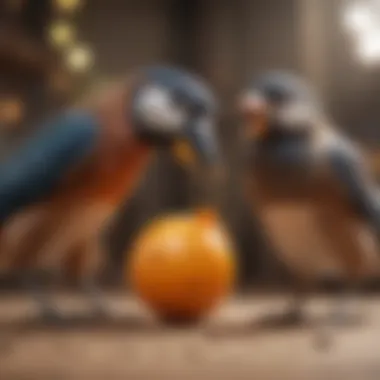
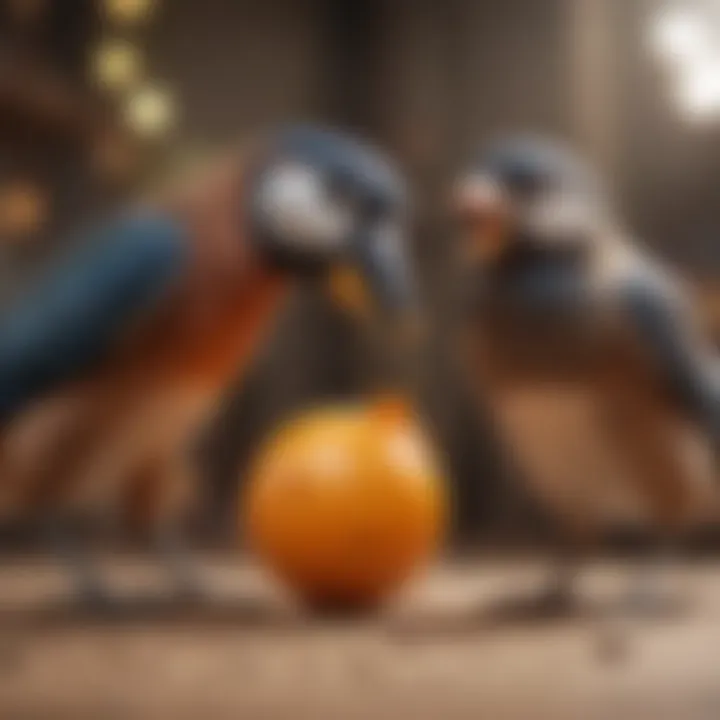
Understanding Avian Behavior
Understanding the behavior of birds is fundamental for anyone who owns them or is considering bringing a feathered friend into their life. Birds, unlike some other pets, exhibit a complexity in their social interactions and natural instincts that directly impacts their well-being. Knowing their unique behavioral traits is pivotal in creating a healthy environment where they can thrive.
The social nature of birds is particularly intriguing. Many species live in flocks, which provides them not just companionship but also safety from predators. This aspect of their behavior influences how they interact with their human families. Birds that are kept in solitude often display signs of stress or boredom, which underscores the importance of providing them with engaging activities and socialization opportunities. A deeper understanding of their social structures can guide bird owners in fostering a more harmonious living arrangement for both bird and caretaker.
Moreover, when discussing avian behavior, it’s crucial to highlight natural behaviors that they engage in. Birds have instinctive tendencies which include foraging, exploring, and climbing. Providing extra large bird toys that mimic these natural activities can be immensely beneficial. Toys that facilitate climbing or involve puzzles encourage birds to engage in their natural behaviors, thus promoting their overall well-being.
In summary, comprehending avian behavior allows bird owners to tailor their environments and enrichment tools appropriately, ensuring both mental and physical stimulation. This knowledge is not just beneficial; it serves as a foundation for fostering happy and healthy birds.
The Social Nature of Birds
Birds are inherently social creatures, and their exchanged interactions can be as vibrant as a canvas painted with myriad colors. Most species thrive in flocks, where they establish intricate social hierarchies. The ability to communicate visually and audibly is central to these interactions. Owners need to understand that social isolation can lead to distress in pet birds.
Some key elements include:
- Communication: Birds use various sounds to convey messages— from calling to signaling alarm. An owner's familiarity with these sounds aids in responding appropriately to their bird's needs.
- Hierarchy and Bonds: In the wild, birds form bonds within their flocks, establishing ranks that can influence access to resources. This can also extend to their relationships with humans. Treats and respect for their space can help establish a good rapport.
- Playtime: Social play is vital. Birds enjoy engaging with their owners during interactive toy sessions or even during simple activities, which serve as enrichment tools.
Thus, acknowledging the social nature of birds encourages pet owners to create engaging environments, which, in turn, can lead to happier, healthier pets.
Exploring Natural Behaviors
The behaviors birds exhibit in nature are key indicators of their needs and preferences. Understanding these natural behaviors allows owners to better cater to their birds' instincts. For instance, in their natural habitat, most birds spend a significant amount of time foraging for food— a task that demands exploration and creativity.
To effectively promote well-being, consider the following aspects of their natural behaviors:
- Foraging: Offer toys that dispense treats when solved, which mimics their instinct to search for food among foliage.
- Climbing: Birds are expert climbers. Toys that allow them to climb can replicate their evolutionary adaptations and enhance their physical health.
- Vocalizations: Birds often communicate through vocal calls to express needs and establish territory. Engaging with colorful toys can evoke sounds of excitement as they interact with their environment.
Understanding these behaviors adds depth to the relationship between bird owners and their pets, leading to a fulfilling companionship. Engaging in activities that promote these natural instincts not only enriches their environment but also reinforces the owner-bird bond.
"A well-enriched environment speaks volumes about a bird's happiness, much more than mere food and a cage can."
Establishing a relationship with a pet bird requires an awareness of their behaviors, both social and natural. By cultivating this understanding, owners can effectively create a more vibrant and emotionally fulfilling experience for their feathered companions.
The Importance of Enrichment
Enrichment plays a pivotal role in ensuring the overall well-being of avian companions. Understanding why this concept is so essential can help bird owners provide the right tools and environment for their pets. Extra large bird toys serve as a crucial part of this enrichment strategy, offering a variety of benefits that go beyond mere entertainment.
Enrichment can be defined as the process of improving the living conditions of a pet by providing them with various stimuli. This not only includes physical toys but also activities that replicate their natural behaviors. The primary objective is to fulfill psychological needs, reduce stress, and prevent behavioral issues.
When birds are confined for long periods, boredom can set in quickly. An enriched environment fosters curiosity, encourages play, and stimulates learning. These elements can ultimately lead to a more fulfilling life for the bird, reducing the risk of destructive habits that may develop from a lack of engagement. Bird owners have the responsibility to create an environment that encourages exploration and play.
Defining Enrichment in Avian Context
In the context of avian care, enrichment encompasses a range of experiences, from toys to interactive activities. Simply having a spacious cage with perches is not enough to guarantee a stimulating environment. To foster true enrichment, it involves understanding the natural instincts of birds, such as foraging, climbing, and socializing.
- Foraging Opportunities: Birds in the wild spend a significant amount of time searching for food. By introducing foraging toys or hidden treats, owners can mimic this behavior, allowing their birds to engage their mental faculties.
- Social Engagement: Many birds are highly social creatures. Incorporating toys that promote interaction with humans or other birds can satisfy their social needs.
- Physical Activity: Encouraging movement through toys that require climbing or swinging can help promote physical health and combat obesity.
Effective enrichment must consider the unique traits of each bird species. This tailored approach allows owners to cater to specific needs and preferences, ensuring that the enrichment provided is both engaging and beneficial.
Mental Stimulation and Bonding
The benefits of mental stimulation in birds cannot be overstated. Activities that challenge their cognitive skills keep them engaged and happy. Extra large bird toys designed to challenge problem-solving skills are a great way to provide this stimulation. Toys like puzzle feeders, for example, encourage birds to think critically about how to access their treats. This not only keeps them entertained but also supports their mental health by reducing stress and anxiety.
Additionally, bonding between birds and their owners is often strengthened through interactive play. Spending time together while engaging with toys fosters a relationship built on trust and affection. When a bird recognizes that playtime with its owner is enjoyable, it reinforces the bond, making the bird more inclined to engage positively.
"The more interactive the toy, the stronger the bond can become. Birds thrive on positive social interactions.”
In summary, enriching a bird's environment is crucial for their well-being. Providing extra large bird toys specifically designed for interactivity and engagement promotes mental stimulation, physical health, and emotional connections between bird and owner. Just as in relationships, time and thought invested in understanding a bird’s preferences result in a happier, healthier companion.
Types of Extra Large Bird Toys
When it comes to keeping our feathered friends happy and engaged, the right toys play a critical role. Extra large bird toys are not just oversized versions of regular toys; they are specifically designed to cater to the natural instincts of birds. These toys provide mental stimulation, physical activity, and a sense of security and comfort in their environment. It’s important to understand the various types of extra large bird toys available, as they contribute significantly to overall enrichment.
Interactive Toys
Puzzle Feeders
Puzzle feeders represent an intriguing blend of fun and challenge for your bird. They often require the bird to figure out how to access treats, engaging their problem-solving skills. This added layer of complexity can promote cognitive development, something that is highly beneficial for pet birds.
One distinguished characteristic of puzzle feeders is their ability to transform snack time into a playful activity. Birds love to explore and manipulate items, so placing treats inside these feeders encourages them to use their beaks and feet in ways that mimic natural foraging behaviors. While many pet bird owners find these toys popular for keeping their pets mentally sharp, they must remember that it might take time for some birds to understand how to use them.
Advantages include:
- Encourages natural foraging behavior: Birds instinctively seek food, and puzzle feeders imitate this instinct.
- Mental engagement: They help stave off boredom which can lead to behavioral issues.
However, some disadvantages include
- Potential frustrations: If the puzzle is too difficult, it might cause stress. Careful selection of feeder complexity is needed to suit the individual bird’s abilities.
Manipulative Toys
Manipulative toys invite your bird to interact in ways that stimulate their motor skills. These toys usually consist of various components that birds can move, pull, or twist. Such toys not only keep birds busy but also help them develop dexterity.
What sets manipulative toys apart is the variety they offer. From tugging ropes to rings that can spin, there’s usually something to pique any bird's curiosity. They allow for personalized playtime. Birds can spend countless hours investigating every nook and cranny, which speaks to their natural instincts to explore.
The benefits include:
- Skill development: These toys hone fine motor skills and provide a physical challenge.
- Sustained attention: Birds tend to focus longer on activities that require their active engagement.
On the flip side, manipulative toys can have drawbacks:
- Durability concerns: Some may not withstand the beak strength of larger birds. It's important to choose toys made from robust materials.
Swinging and Climbing Structures
Perches and Swings
Perches and swings not only create a fun environment but also are crucial for a bird’s physical health. These structures offer different heights, allowing birds to exercise their flight muscles and maintain bone density while providing a place to rest.
The ease of accessibility makes perches and swings an ideal choice among bird owners. They can easily be placed in various locations to encourage your bird to move around its habitat, making them an integral part of any enclosure. The rhythmic motion of a swing can add a soothing element to your bird's space, mimicking what they might find in nature.
Benefits include:
- Encourages exercise: Regular movement is vital for a bird’s physical condition.
- Variety in resting spots: Different perches and swings can offer both comfort and a change of scenery.
However, it’s important to be aware of:
- Safety risks: Ensure that swings and perches are strategically positioned to avoid any risk of injury.

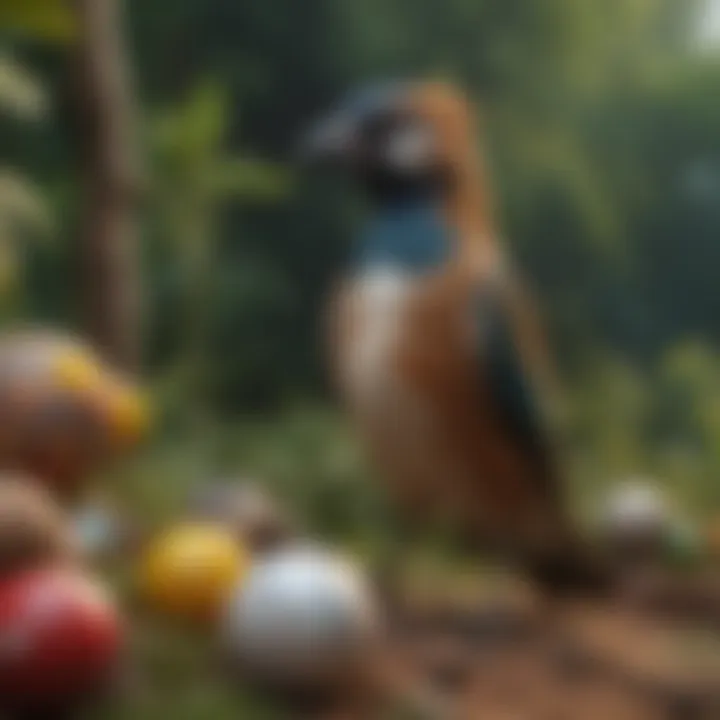
Climbing Ropes
Climbing ropes add an adventurous aspect to a bird's environment. These ropes allow birds to move freely, climb, and explore. They can be attached to the cage walls or frameworks, offering endless possibilities for movement.
The key characteristic of climbing ropes is their versatility. They come in various lengths and materials, catering to the climbing habits of different bird species. Birds often prefer to scale heights in their natural habitat, and providing a climbing rope replicates this instinctual behavior.
The advantages are clear:
- Encourages natural climbing behavior: Birds love to climb, and this satisfies that instinct.
- Multifunctional use: Ropes can be adjusted to create new paths and challenges within their living space.
However, potential downsides can arise:
- Easy wear and tear: If not made from durable materials, the ropes could fray over time, posing a potential risk.
Foraging Toys
Hidden Treat Dispensers
Hidden treat dispensers are designed to challenge a bird's natural foraging instincts by requiring them to work for their food. This not only keeps them busy but also reinforces their instinctual behaviors. These toys typically involve a mechanism that releases treats when manipulated, encouraging exploration.
The standout feature of these dispensers is their ability to extend feeding time. Instead of eating quickly from a bowl, birds will engage with the toy to get their rewards. This extends their outreach during mealtime and promotes engagement with food.
Advantages include:
- Extended engagement: Birds are occupied for a longer duration.
- Stimulates mental activity: It encourages critical thinking and problem-solving.
However, be cautious of:
- Complexity levels: Some birds may find these challenging. Monitoring their interactions with these toys initially is crucial.
Coconut Shell Toys
Coconut shell toys are another fabulous option for avian enrichment. Made from natural materials, these toys offer an authentic experience. Birds can chew, shred, and play with them, satisfying their instinct to manipulate objects in their environment.
The key feature of coconut shell toys is their environmentally friendly nature. They're often considered safe since they don't contain any harmful chemicals. Birds can engage with these toys in various ways, from foraging for treats hidden inside to chewing on the outer shell.
Pros include:
- Natural materials: Safe and non-toxic, aligning with many pet owners’ desires for sustainable goods.
- Engaging and destructive play: They cater to the chewing habits of many birds, which is often crucial in preventing boredom.
On the downside, keep in mind:
- Cleaning challenges: These may require regular maintenance due to debris created from chewing.
In summary, understanding the diverse types of extra large bird toys is essential for enriching the lives of pet birds. Each toy serves a unique purpose, from promoting physical activity to stimulating mental engagement. By selecting the right toys, bird owners can create a vibrant and fulfilling environment for their avian companions.
Benefits of Extra Large Bird Toys
When it comes to improving the well-being of pet birds, extra large bird toys hold a significant role. Not only do these toys provide a source of entertainment, but they also contribute to the overall physical and mental health of our feathered friends. With a proper selection of toys, owners can actively engage their birds and foster an enriching environment that supports their natural instincts. Let's delve into the key benefits these toys offer.
Promoting Physical Activity
Having larger toys allows birds to stretch their wings and muscles. The active design of these toys encourages birds to move around and play, mimicking behaviors they would naturally engage in while foraging or climbing in the wild. Climbing ropes and swings, for example, aren’t just fun; they invite pet birds to exercise and maintain their healthy weight, which is crucial since obesity in birds can lead to a host of health problems.
- Benefits of Physical Activity:
- Weight Management: Playing with large toys helps to keep your bird in shape.
- Muscle Strengthening: Climbing and swinging enhance muscle tone.
- Bone Health: Active play supports stronger bones due to increased movement.
A well-exercised bird is a happy bird, and introducing extra large toys can significantly impact their daily activity levels.
Enhancing Cognitive Skills
Extra large bird toys often come equipped with features designed to stimulate a bird’s mind. Toys that require manipulation, like puzzle feeders or those that have compartments to find treats, encourage problem-solving skills. This sort of engagement is essential. It not only combats boredom but also allows the bird to flex its mental muscles.
Birds are curious creatures by nature, and they thrive when they can explore their surroundings. Toys that challenge them can lead to better mental acuity and reduce feelings of frustration or anxiousness.
- Cognitive Enhancement Benefits:
- Problem Solving: More intricate toys encourage critical thinking.
- Novel Interactions: Exposure to new toys keeps their environment fresh and more interesting.
- Memory Stimulation: Remembering how to interact with toys reinforces learning.
Investing in stimulating, extra large toys can pay off in smooth interactions with your bird, ensuring they are both entertained and mentally sharp.
Reducing Boredom and Related Issues
Boredom can have adverse effects on pet birds. Left unaddressed, it can lead to destructive behavior, such as excessive screaming or feather plucking. Extra large bird toys play a pivotal role in alleviating these issues.
These toys provide a variety of textures, shapes, and movements that capture your bird’s attention. An engaged bird is less likely to fall into the trap of boredom that leads to unwanted behaviors. By rotating and combining various toys, you can maintain a stimulating environment.
- Benefits of Reducing Boredom:
- Behavioral Adjustment: Minimizes potential behavior issues stemming from boredom.
- Social Interaction: Engaging with toys can satisfy a bird’s need for interaction when owners are not around.
- Overall Happiness: Happy birds exhibit fewer stress-related behaviors.
Ultimately, extra large bird toys enhance the avian experience, allowing pet owners to contribute to their birds' happiness and contentment. By providing an array of stimulating options, owners can effectively combat the pitfalls of boredom and encourage a fulfilling lifestyle.
Selecting the Right Toys for Your Bird
Choosing the right toys for your bird isn't merely about aesthetics or what catches your eye in the shop. It involves understanding the unique needs of your avian friend. Each species has its own behaviors, preferences, and physical capabilities. Toys can play a crucial role in a bird's happiness and overall health. By selecting toys thoughtfully, you can foster a stimulating environment that leads to better mental health and physical exercise.
Considering Bird Size and Species
When it comes to selecting toys, the size and species of your bird are paramount. A toy suitable for a small budgie might easily pose a danger for a larger macaw. Size affects both safety and engagement. A large toy that holds a ton of fun might overwhelm a small bird, while too small a toy means a big bird can go to town on it, making it dangerous for their beak or stomach.
Birds like cockatoos, known for their playful nature, benefit from various interactive toys that stimulate their problem-solving skills. On the flip side, a quieter species, like a canary, may prefer simpler toys that they can peck and examine without too much commotion.
Key Considerations:
- Species-Specific Preferences: Recognizing which types of toys resonate with your particular bird species can increase their engagement.
- Safety and Size: Always double-check the dimensions and shapes of the toys—too small can be a choking hazard, while too large might be ignored.
Material Safety and Durability
Selecting toys made from safe materials and ensuring their durability contributes significantly to the overall experience of toy use for your bird. You want something that will stand the test of time and keep your bird safe as they play.
Non-Toxic Materials
Opting for non-toxic materials is absolutely crucial when selecting toys. Not only do these materials prevent harmful toxins from entering your bird's system, they offer peace of mind to bird owners. Ideally, materials like natural wood, sisal rope, and untreated leather should be on your radar. A key characteristic of non-toxic materials is that they often come from sustainable sources, which is both an environmental and health win.
One unique feature is that many brands will proudly display their safety certification. Look for stamps or markings that indicate the product has been tested for bird safety. The benefit of choosing non-toxic materials is clear— it ensures your feathered companion's health and safety while they engage in their habitat, leading to enhanced physical and cognitive stimulation.
Durable Construction
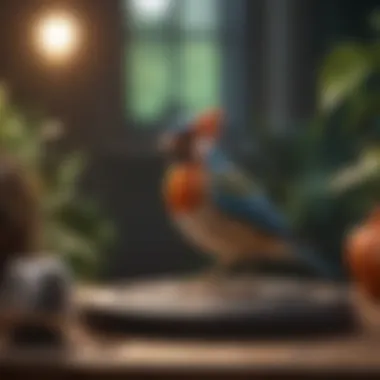
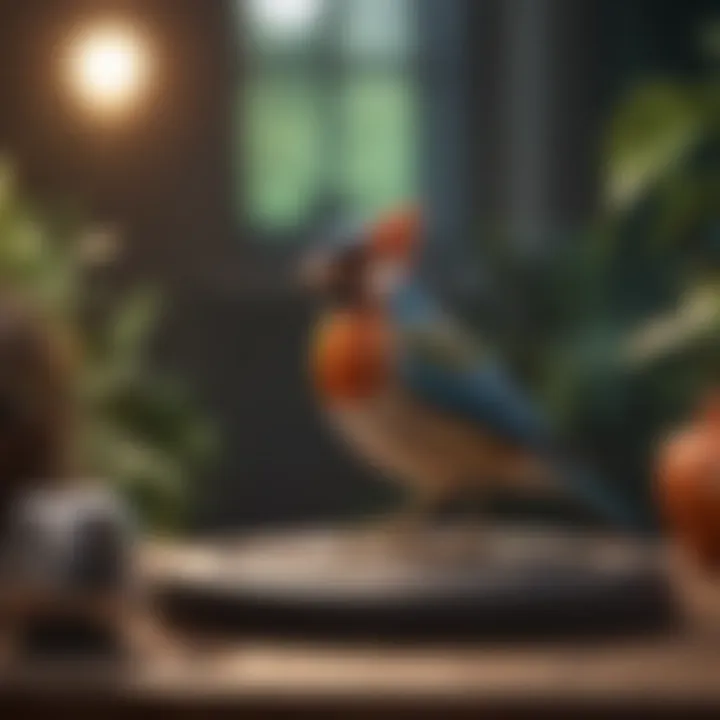
Durable construction in bird toys cannot be emphasized enough. Birds, especially larger species, have strong beaks and a tendency to chew. If a toy falls apart easily, it poses a choking hazard or could lead to ingestion of harmful pieces. A key characteristic of durable construction is the use of high-grade materials that can withstand pecking and climbing.
High-quality toys may come at a steeper price, but they prove cost-effective in the long run. Investing in durable toys means less frequent replacements and, more importantly, less frustration for your bird when their toy breaks during play. One unique advantage is that many of these well-constructed toys are also designed to be easily cleaned, ensuring hygiene without sacrificing playtime.
"A bird's environment should be a playground, not a prison. Choose toys wisely to unlock their inner joy."
Selecting the right toys requires attention to your bird’s specific needs and habits, ensuring their space is enriching and safe.
Introducing Toys to Your Bird
Introducing new toys to your bird is a crucial component of enhancing their environment. It's not just about adding fun to their day; it's about fostering a stimulating atmosphere that promotes natural behaviors, enriches their mental faculties, and satisfies their curiosity. Birds, like many pets, can be cautious of novel items in their space. If toys are introduced suddenly, it can lead to anxiety or even fear. A well-considered approach ensures that birds can explore their new playthings without the added stress. Moreover, understanding the dynamics of how to present these toys can significantly improve your bird's engagement and willingness to interact with them. Thus, mastering the art of introduction forms the bedrock of successful enrichment.
Gradual Prelude Techniques
- Start Small: Begin with one toy at a time to avoid overwhelming your feathered friend. A gentle introduction is key.
- Choose Familiar Shapes: Opt for toys that mirror shapes or colors of items they've previously enjoyed. This familiarity can ease them into acceptance.
- Incorporate in Playtime: Position the toy within play areas during supervised time, allowing them to explore it organically. Engage your bird using another toy to draw attention.
- Observation Over Interaction: Let them investigate at their own pace. It's preferable to observe rather than push interaction during initial introductions.
- Rotate Toys: Every few weeks, switch out the toys to keep their interest piqued without introducing too many new elements at once.
Monitoring Initial Reactions
Observing your bird’s behavior when new toys are introduced is crucial to understanding their preferences and emotional responses. Here are some things to keep an eye on:
- Behavioral Changes: Look for signs of curiosity or apprehension. If your bird is cautiously approaching or tilting their head, they might be engaging.
- Playfulness: A clear sign of acceptance is their willingness to play. If they start to tug, chew, or climb on the toy, you’re on the right track.
- Avoidance or Fear: If your bird retracts or tries to escape, this signals we may need to scale back. Returning to the gradual introduction techniques can help.
- Vocalizations: Some birds might express their feelings through vocalizations. Happy chirps often denote curiosity, whereas squawking could indicate discomfort.
"Understanding your bird's initial reactions to new toys is not only vital for their happiness but also helps in building a stronger bond between you and your pet."
In essence, a harmonious introduction of toys can transform the living space of your bird into a vibrant playground. When executed with patience and attentiveness, you not only provide them with enrichment but also create lasting enjoyment and curiosity.
Maintaining and Cleaning Extra Large Bird Toys
Caring for extra large bird toys goes beyond mere aesthetics; it plays a crucial role in maintaining the overall health and happiness of your avian friends. Just think about it: a dirty or worn-out toy can be a breeding ground for harmful bacteria and parasites that could affect your bird's health. Not only that, but a well-maintained toy can significantly enhance your birds' play experience, keeping them engaged and mentally stimulated.
Regular maintenance also assures bird owners that the play equipment is safe for their companions. By routinely inspecting and cleaning, you reduce the risks of accidents or health issues, promoting a clean and enjoyable environment. When bird owners take the time to maintain and clean these toys, they are essentially investing in their pet's quality of life.
Routine Cleaning Practices
To keep things spick-and-span for your avian buddies, there are some straightforward cleaning practices that can be adopted. Here’s a simple route to follow:
- Daily Spot Cleaning: Just like we might tidy up our own rooms, it’s good to look at the toys each day. Check for droppings, leftover snacks, or any debris that might have collected. Use a damp cloth to wipe down surfaces if needed.
- Weekly Deep Cleaning: Set aside a day each week to give the toys a thorough clean. Use a mixture of warm water and mild soap. Soak toys, especially those that are made from untreated wood, while ensuring that any synthetic parts are scrubbed well. Avoid harsh chemicals that could harm your bird.
- Natural Disinfectants: For an extra layer of cleanliness, consider vinegar. It’s a safe and effective natural disinfectant. Mix it with some water, and you can wipe down the toys without worry. Just be sure to rinse everything well afterwards!
- Drying: Air-dry the toys completely before putting them back. This can help prevent mold or mildew, which could develop in a damp area. It's important not to rush this step.
Incorporating these practices is not only beneficial; it turns into a bonding time between you and your bird. While you clean the toys, observe how your feathered friend interacts with them—this can also help in understanding what they prefer!
Signs of Wear and Replacement Guidelines
Over time, even the sturdiest bird toys can show signs of wear and tear, and knowing when to replace them is essential for your bird's safety. Here are some indicators to look out for:
- Brittle Material: If you notice that a toy, especially wooden ones, has become splintered or brittle, it’s best to replace it. Splinters can pose serious injury risks.
- Fraying Ropes or Cords: Ropes are thrilling for climbing but once you notice fraying or loose fibers, toss them out. These can pose choking hazards if ingested.
- Discoloration or Odor: A toy that starts to smell unpleasant or shows signs of significant color fading might be harboring bacteria. It's time for a change!
- Chewing and Damage: If a toy has been chewed down excessively to a point where it’s losing its original form, it might no longer be safe. Birds can consume small pieces, which is not good for their digestive system.
Regularly assess toys to ensure they're not just functioning but also providing the safest play environment possible for your birds. A good rule of thumb? If you’re ever in doubt whether a toy is safe, it’s probably best to err on the side of caution and replace it. Keeping your bird's playthings fresh and well-maintained not only fortifies their health but also elevates their overall play experience!
"A clean bird toy is a happy bird toy."
Refreshing your bird's playthings may seem like just another chore, but in reality, it’s an opportunity to provide a healthier, more engaging atmosphere for your pet. With the right routine, you can keep their toys in tip-top shape, ensuring that every play session is a safe, fun, and enriching time.
Creating a Stimulating Environment
Creating a stimulating environment for our feathered friends is a key factor in promoting their overall well-being. Birds are intelligent creatures, with diverse personalities that can flourish or falter based on their surroundings. Providing an engaging habitat not only boosts their mental acuity but also helps reduce stress and destructive behaviors. It’s like creating a miniature world tailored specifically to them, where every corner invites exploration and play.
Combining Toys with Other Enrichment Tools
One effective strategy for enhancing a bird's environment is to combine toys with other enrichment tools. This can include natural branches, mirrors, and even gentle music or sounds of nature. By creating a multi-faceted play area, we cater to various senses and encourage birds to participate in different activities throughout their day.
- Use natural elements: Incorporating elements like real wood branches, vines, or even a small sandbank can encourage foraging behavior. Birds instinctively enjoy pecking and searching for food within natural substrates, which keeps them physically and mentally engaged.
- Integrate puzzles: Puzzle toys that hide treats can be extremely effective in combining a toy with an interactive challenge. This not only stimulates their problem-solving skills but also relieves boredom.
- Provide social interaction: If possible, having more than one bird can foster a social environment. Letting them interact while they investigate new toys can lead them to mimic behaviors that promote healthy habits as well.
In short, blending toys with various enrichment resources leads to a richer habitat.
Arranging Toys for Maximum Engagement
How you arrange toys in your bird's environment matters just as much as the toys themselves. A well-thought-out arrangement can encourage exploration, reduce loneliness, and promote activity. It’s akin to designing a vibrant playground for children — every detail counts.
- Strategic placement: Positioning toys at different heights can pique the bird's interest. Using vertical space by hanging swings and climbing structures can invite them to move around and exercise, while lower setups can be explored at their leisure.
- Create zones: Think of your bird's space in terms of zones. A foraging area, a climbing zone, and a resting space can be established to help them feel secure as they explore. Zone creation gives your bird the chance to choose its next adventure based on its mood.
- Rotate toys frequently: Birds can easily become accustomed to their toys. To combat this, rotating the toys every couple of weeks gives them a sense of novelty. Even a minor change in placement or swapping toys can encourage them to interact with their environment in fresh ways.
In sum, how toys are arranged and combined with other enrichment tools can make a substantial difference in your bird's daily life. A thoughtfully curated play space not only stimulates their minds but also strengthens the bond between you and your avian companion.
"A vibrant environment can make the difference between a bored bird and a happy, playful one."
By being intentional about the design of your bird's space, you're laying the groundwork for an enriched avian experience. Whether through clever arrangement of toys or incorporating natural elements, every effort counts toward nurturing their well-being.
Observing Your Bird's Behavior
Observing your bird’s behavior is more than just a casual activity; it’s a key element in understanding their needs and enhancing their quality of life. By watching how your feathered friend interacts with their environment, you can gain insights that are crucial for their wellbeing. This section focuses on specific elements, benefits, and considerations regarding the observation of your bird’s behavior, especially in relation to extra large bird toys.
Understanding Play Behavior
Birds are naturally playful creatures. Engaging in play is vital for their mental health and overall vigor. Extra large bird toys provide a platform for this behavior, offering challenges that stimulate their instincts to forage, climb, and interact. When you observe your bird playing with these toys, you are likely to notice a series of actions: pecking, climbing, swinging, and sometimes even vocalizing in excitement.
This play behavior can be a telling sign of your bird's mood. A bird that seems uninterested in its toys may signal boredom or even stress. Conversely, an active bird that approaches and engages with toys demonstrates curiosity and confidence.
Furthermore, different species exhibit unique play behaviors. For instance, Amazon parrots might prefer puzzle toys that challenge their problem-solving skills, while cockatiels may enjoy swinging structures that facilitate movement and balance. Understanding these tendencies can aid you in selecting the right toys and creating an enriching environment.
Identifying Preferences in Toys
Each bird has its own set of preferences influenced by personality, species, and curiosity levels. Identifying what toys your bird favors can enhance its playtime experience. Pay close attention to which toys tend to catch your bird’s eye. Do they gravitate towards foraging toys, or are manipulatives like knots and hooks more appealing?
"Birds are like kids when it comes to toys. They’re often drawn to what piques their interest, often in the most surprising ways."
You might consider keeping a few different types of toys available to observe your bird’s interactions. The aim is to rotate these toys regularly to maintain interest and prevent monotony. Take note of specific actions, such as the excitement of tearing at a hidden treat or the determination shown while working through a puzzle. These insights provide invaluable information about your bird’s likes and help ensure they are engaged and content.
Moreover, how your bird interacts with toys may also indicate its mood and mental health. Toys should be seen not only as playthings but as essential tools for development and social interaction. A toy that promotes physical activity can help alleviate boredom while also strengthening the bond between you and your bird.
In sum, observing your bird’s behavior, particularly in the context of play, offers profound insight into its needs and preferences. This knowledge equips you to tailor their environment and enhance their enrichment experience through thoughtfully selected extra large bird toys.
Epilogue
In the grand tapestry of avian companionship, the role of extra large bird toys cannot be overstated. These toys are not merely playthings; they are pivotal components that contribute significantly to the overall well-being of our feathered friends. First and foremost, they serve as essential tools for mental and physical stimulation, addressing the innate need for engagement that birds possess. Such stimulation not only keeps them entertained but also fosters critical cognitive development.
The Lasting Impact of Enrichment
Enrichment through extra large toys leads to long-term benefits for your pet bird. By providing a variety of textures, colors, and movements, these toys encourage exploration and discovery—activities that resemble the wild behaviors of their ancestors. The more your bird interacts with different toys, the better their problem-solving skills become. Additionally, engaging with these toys can prevent boredom, which often leads to undesirable behaviors like excessive screaming or feather plucking. It’s like offering your bird a small playground that provides both physical exercise and a chance to exhibit their natural instincts.
"Every bird requires interaction and stimulation—it's not just a luxury, it's a necessity for their happiness."
Embracing the Journey of Bird Ownership
Owning a pet bird is a rewarding experience filled with unique challenges and joyous moments. When birds are provided with the right toys, like extra large ones, it deepens the relationship between the owner and the bird. Observing how your bird engages with its toys can reveal insights about its preferences and personality traits. Understanding these aspects can make you a better caretaker and enhance your bond.
In essence, embarking on this journey of bird ownership, while ensuring access to quality enrichment tools, allows for a fulfilling experience not just for the bird but also for the owner. The responsibility of providing endless joy and enrichment ultimately contributes to a vibrant, healthy life for your pet bird.















